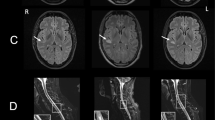Abstract
Fulminant hepatitis due to acute hepatitis C virus (HCV) infection is rarely observed. We present a case study of a 21-year-old male patient who developed HCV-associated fulminant hepatitis after receiving steroid pulse therapy for optic neuritis. Despite daily plasmapheresis, the disease progressed to irreversible liver failure with grade 3 hepatic encephalopathy by the 6th day after symptom onset. The patient received a liver transplant on the 8th day. Serum anti-HCV antibody was negative at that time, but became positive on the 12th day. Positive HCV RNA in the serum at admission was reported after transplantation. Positive changes in anti-HCV antibodies and acute hepatitis with massive necrosis in the histology of the explanted liver indicated fulminant hepatitis due to acute HCV infection. Because of severe hepatitis recurrence, he started 12 months of interferon therapy on the 48th day, and obtained sustained virological response. His anti-HCV antibodies became negative again by 1.5 years after cessation of therapy. HCV genomes recovered from the patient’s serum on the 7th and 48th days revealed 2 different clones out of 20 clones with 30 % amino acid difference in hypervariable region 1 of HCV second envelope glycoprotein. One of the 2 clones expanded further after liver transplantation. We conclude that early diagnosis of HCV-associated fulminant hepatitis requires the detection of HCV RNA in the serum. Severe hepatitis recurrence after liver transplantation might occur in patients with fulminant hepatitis due to HCV because of its monoclonal expansion.



Similar content being viewed by others
Abbreviations
- HCV:
-
Hepatitis C virus
- HVR:
-
Hypervariable region
References
Kato N. Molecular virology of hepatitis C virus. Acta Med Okayama. 2001;55:133–59.
Kamal SM. Acute hepatitis C: a systematic review. Am J Gastroenterol. 2008;103:1283–97.
Farci P, Alter HJ, Shimoda A, et al. Hepatitis C virus-associated fulminant hepatic failure. N Engl J Med. 1996;335:631–4.
Kato T, Furusaka A, Miyamoto M, et al. Sequence analysis of hepatitis C virus isolated from a fulminant hepatitis patient. J Med Virol. 2001;64:334–9.
Farci P, Shimoda A, Coiana A, et al. The outcome of acute hepatitis C predicted by the evolution of the viral quasispecies. Science. 2000;288:339–44.
Oketani M, Ido A, Nakayama N, Intractable Hepato-Biliary Diseases Study Group of Japan, et al. Etiology and prognosis of fulminant hepatitis and late-onset hepatic failure in Japan: summary of the annual nationwide survey between 2004 and 2009. Hepatol Res. 2013;43:97–105.
Mochida S, Takikawa Y, Nakayama N, et al. Diagnostic criteria of acute liver failure: a report by the Intractable Hepato-Biliary Diseases Study Group of Japan. Hepatol Res. 2011;41:805–12.
Saludes V, Esteve M, Casas I, et al. Hepatitis C virus transmission during colonoscopy evidenced by phylogenetic analysis. J Clin Virol. 2013;57:263–6.
Grebely J, Page K, Sacks-Davis R, et al. The effects of female sex, viral genotype, and IL28B genotype on spontaneous clearance of acute hepatitis C virus infection. Hepatology. 2014; 59:109-120.
Kato N, Sekiya H, Ootsuyama Y, et al. Humoral immune response to hypervariable region 1 of the putative envelope glycoprotein (gp70) of hepatitis C virus. J Virol. 1993;67:3923–30.
Ray SC, Wang YM, Laeyendecker O, et al. Acute hepatitis C virus structural gene sequences as predictors of persistent viremia: hypervariable region 1 as a decoy. J Virol. 1999;73:2938–46.
Acknowledgments
We thank Chizuru Mori for technical assistance and Yuko Yasuda for coordination of liver transplantation.
Disclosures
Conflict of Interest: All the authors have no conflict of interest.
Human/Animal Rights: All procedures followed were in accordance with the ethical standards of the responsible committee on human experimentation (institutional and national) and with the Helsinki Declaration of 1975, as revised in 2008(5).
Informed Consent: Informed consent was obtained from all patients for being included in the study.
Author information
Authors and Affiliations
Corresponding author
Rights and permissions
About this article
Cite this article
Kanzaki, H., Takaki, A., Yagi, T. et al. A case of fulminant liver failure associated with hepatitis C virus. Clin J Gastroenterol 7, 170–174 (2014). https://doi.org/10.1007/s12328-014-0454-x
Received:
Accepted:
Published:
Issue Date:
DOI: https://doi.org/10.1007/s12328-014-0454-x




